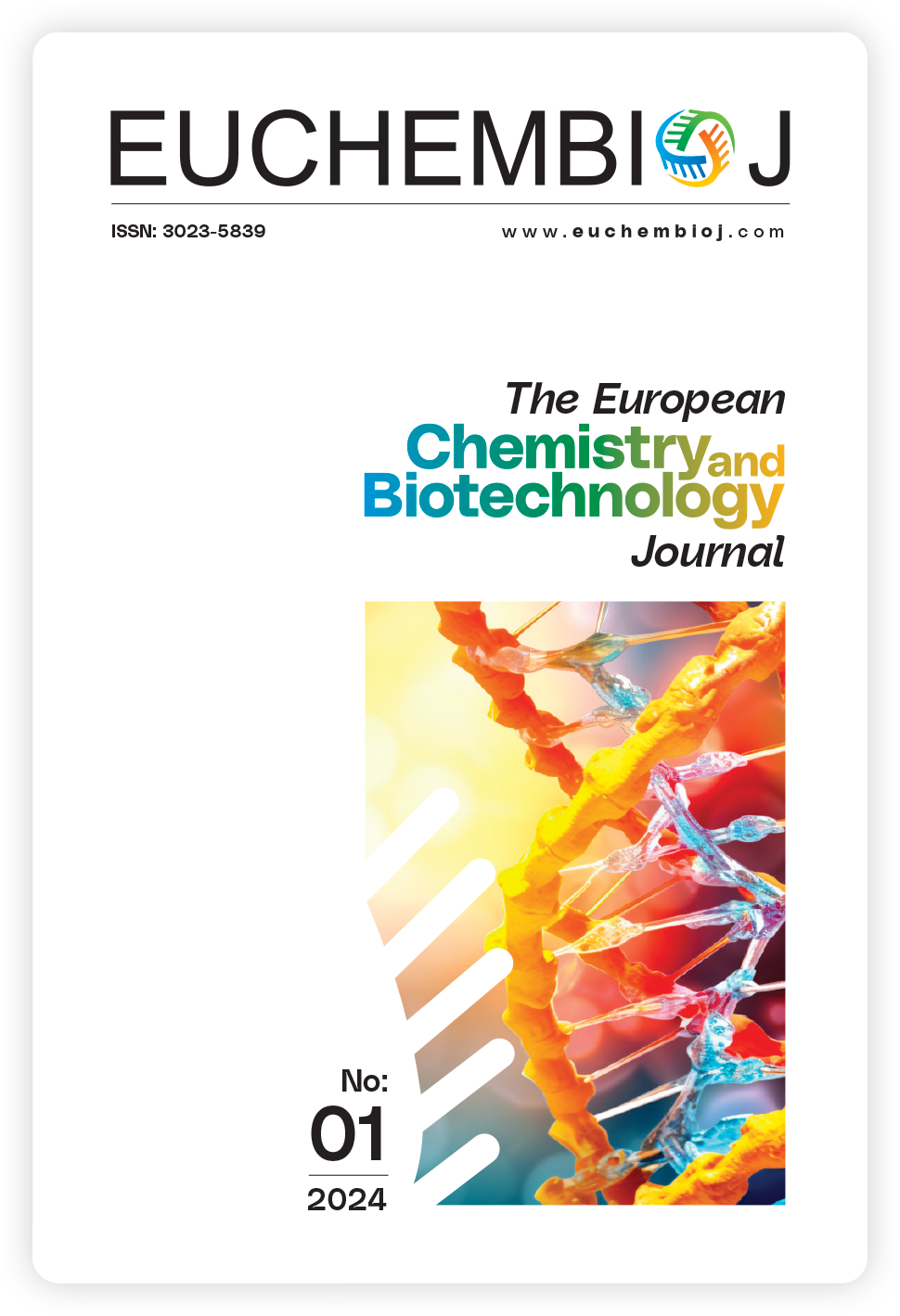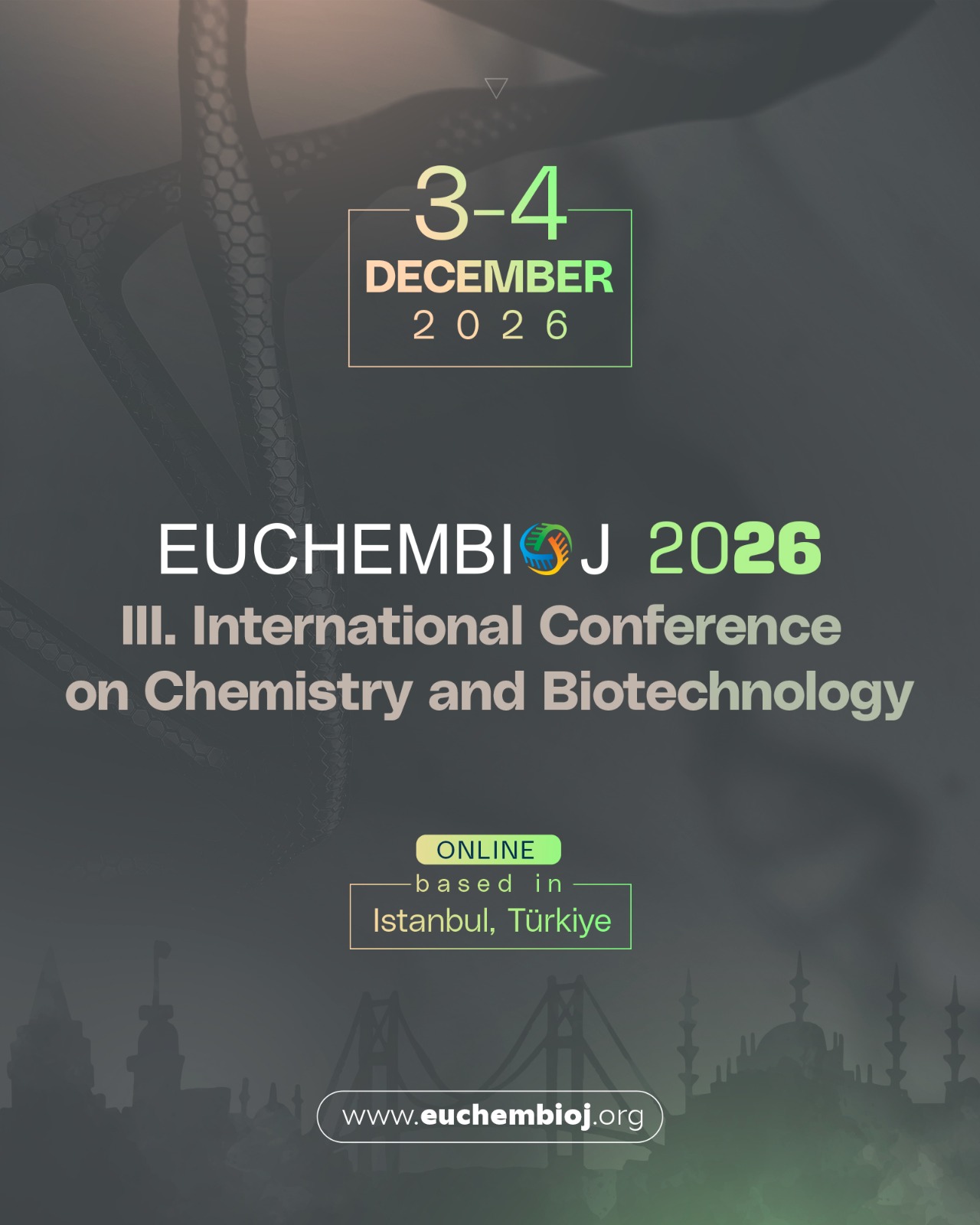Novel N,S-Substituted naphthoquinone analogues from aminonaphthoquinones
DOI:
https://doi.org/10.62063/ecb-13Keywords:
Aminonaphthoquinone, Naphthoquinone, ThionaphthoquinoneAbstract
In this study, novel N,S-substituted naphthaquinone analogues (2, 4, 6, and 8) were synthesized from the reactions of previously known aminonaphthaquinone derivatives (1, 3, 5, and 7) with allyl mercaptan. 2-(allylthio)-3-(4-phenylpiperazin-1-yl)naphthalene-1,4-dione (2), 2-(allylthio)-3-(4-(2-fluorophenyl)piperazin-1-yl)naphthalene-1,4-dione (4), 2-(allylthio) -3-(4-benzylpiperidin-1-yl)naphthalene-1,4-dione (6) and 2-(4-chlorophenylamino)-3-(allylthio)naphthalene-1,4-dione (8) were obtained from the reactions of 2-chloro-3-(4-phenylpiperazin-1-yl)naphthalene-1,4-dione (1), 2-chloro-3-(4-(2-fluorophenyl)piperazin-1-yl)naphthalene-1,4-dione (3), 2-(4-benzylpiperidin-1-yl)-3-chloronaphthalene-1,4-dione (5), and 2-(4-chlorophenylamino) -3-chloronaphthalene-1,4-dione (7) with allyl mercaptan according to the general synthesis procedure. Synthesized new naphthaquinone analogues (2, 4, 6, and 8) were purified by column chromatography. The chemical structures of these novel N,S-substituted naphthaquinone analogues were characterized by spectroscopic methods (FT-IR, NMR, and MS).
References
Ajjan, F. N., Mecerreyes, D., & Inganäs, O. (2019). Enhancing energy storage devices with biomacromolecules in hybrid electrodes. Biotechnology journal, 14(12), e1900062. https://doi.org/10.1002/biot.201900062 DOI: https://doi.org/10.1002/biot.201900062
Aziz, M.H., Dreckschmidt, N.E., & Verma, A.K. (2008). Plumbagin, a medicinal plant-derived naphtoquinone, is a novel inhibitor of the growth and invasion of hormone refractory prostate cancer. Cancer research, 68(21), 9024-9032. https://doi.org/10.1158/0008-5472.CAN-08-2494 DOI: https://doi.org/10.1158/0008-5472.CAN-08-2494
Borghese, R., Brucale, M., Fortunato, G., Lanzi, M., Mezzi, A., Valle, F., Cavallini, M., & Zannoni D. (2017). Reprint of extracellular production of tellerium nanoparticules by the photosynthetic bacterium Rhodobacter capsulatus. Journal of hazardous materials, 324, 31-38. https://doi.org/10.1016/j.jhazmat.2016.11.002 DOI: https://doi.org/10.1016/j.jhazmat.2016.11.002
Christiansen, J. V., Isbrandt, T., Petersen, C., Sondergaard, T. E., Nielsen, M. R., Pedersen, T. B., Sørensen, J. L., Larsen, T. O., & Frisvad, J. C. (2021). Fungal quinones: diversity, producers, and applications of quinones from Aspergillus, Penicillium, Talaromyces, Fusarium, and Arthrinium. Applied microbiology and biotechnology, 105(21-22), 8157–8193. https://doi.org/10.1007/s00253-021-11597-0 DOI: https://doi.org/10.1007/s00253-021-11597-0
Cruz, E.H.G., Hussene, C.M.B., Dias, G.G., Diago, E.B.T., Melo, İ.M.M., Rodrigues, B.L., Silva, M.G., Valenca, W.O., Camera, C.A., Oliverira, R.N., Paiva, V.G., Goulart, M.O.F., Cavalcanti, B.C., Pessoa, C., & Silva, EN. (2014). 1,2,3-triazole-, arylamino- and thio-substituted 1,4-naphthoquinones: potent antitumor activity, electrochemical aspects and bioisosteric replacement of C-ring-modified lapachones. Bioorganic & medicinal chemistry, 22(5), 1608-1619. https://doi.org/10.1016/j.bmc.2014.01.033 DOI: https://doi.org/10.1016/j.bmc.2014.01.033
Durán, A.G., Chinchilla, N., Simonet, A.M., Gutiérrez, M.T., Bolívar, J., Valdivia, M.M., & Macías, F.A. (2023). Biological Activity of Naphthoquinones Derivatives in the Search of Anticancer Lead Compounds. Toxins, 15(5), 348. https://doi.org/10.3390/toxins15050348 DOI: https://doi.org/10.3390/toxins15050348
Fries, K., & Kerkow, F. (1922). Uber lineares (Benzo-naptho)-parathiozia, Justus liebigs annalen der chemie, 427(2-3), 281-302. https://doi.org/10.1002/jlac.19224270206 DOI: https://doi.org/10.1002/jlac.19224270206
Hussain, H., Krohn, K., Ahmad, V.U., Miana, G.A., & Green, I.R. (2007). Lapachol:an overview. Archive for organic chemistry, 2, 145-171. http://dx.doi.org/10.3998/ark.5550190.0008.204 DOI: https://doi.org/10.3998/ark.5550190.0008.204
Inagaki, R., Ninomiya, M., Tanoka, K., & Koketsu, M. (2015). Synthesis, characterization and antileukenic properties of naphtoquinone derivatives of lawsone. ChemMedChem, 10(8), 1413-1423. https://doi.org/10.1002/cmdc.201500189 DOI: https://doi.org/10.1002/cmdc.201500189
Kalmayer, J.H., & Petesch, N. (1991). Amino quinone reactions 10. Photoreaction of 2-amino-3-chloro-1,4-napthoquinones. Pharmaceutica acta helvetiae, 66,130-136.
Kar, S., Lefterov, I.M., Wang, M., Lazo, J.S., Scott, C.N., Wilcox, C.S., & Carr, B.I. (2003). Binding and inhibition of Cdc25 phosphates by vitamin K analogues. Biochemistry, 42(35), 10490-10497. https://doi.org/10.1021/bi027418p DOI: https://doi.org/10.1021/bi027418p
Kavaliauskas, P., Opazo, F.S., Acevedo, W., Petraitiene, R., Grybaitė, B., Anusevičius, K., & Petraitis, V. (2022). Synthesis, biological activity, and molecular modelling studies of naphthoquinone derivatives as promising anticancer candidates targeting COX-2. Pharmaceuticals (Basel, Switzerland), 15(5), 541. https://doi.org/10.3390/ph15050541 DOI: https://doi.org/10.3390/ph15050541
Liu, Z., Shen, Z., Xiang, S., Sun, Y., Cui, J., & Jia, J. (2023). Evaluation of 1, 4-naphthoquinone derivatives as antibacterial agents: activity and mechanistic studies. Frontiers of environmental science & engineering, 17(3), 31. https://doi.org/10.1007/s11783-023-1631-2 DOI: https://doi.org/10.1007/s11783-023-1631-2
Lopez, L.I., Flores, S.D., Belmares, S.Y., & Galindo, A. (2014). Napthoquinones: Biological properties and synthesis of lawsone and derivatives. Vitae-revista de la facultad de quimica farmaceutica, 21(3), 248-258. ISSNe 2145-2660 DOI: https://doi.org/10.17533/udea.vitae.17322
López-López, L.I., Rivera-Ávalos, E., Villarreal-Reyes, C., Martínez-Gutiérrez, F., & de Loera, D. (2022). Synthesis and antimicrobial evaluation of amino acid Naphthoquinone derivatives as potential antibacterial agents. Chemotherapy, 67(2), 102-109. https://doi.org/10.1159/000521098 DOI: https://doi.org/10.1159/000521098
Masi, M., Cimmino, A., Tabanca, N., Beanal, J.J., Bloomquist, J.R., Evidente, A. (2017). A survey of bacterial, fungal and plant metabolites against Aedes aegypti (diptera:culicidae), the vector of yellow and dangue fevers and Zika virus. Journal of open chemistry, 15, 156-166. https://doi.org/10.1515/chem-2017-0019 DOI: https://doi.org/10.1515/chem-2017-0019
Nishikawa, Y., Carr, B.I., Wang, M., Kar, S., Finn, F., Dowel, P., Zheng, Z.B., Kernes, J., & Naganathan, S. (1995). Growth inhibition of hepatoma cells induced by K and its analogs. The Journal of biological chemistry, 270(47), 28304–28310. https://doi.org/10.1074/jbc.270.47.28304 DOI: https://doi.org/10.1074/jbc.270.47.28304
Peralta, L.R., Lopez, L.I.L., Belmares, S.Y.S., Cruz, A.Z., Herrara, R.R., & Gonzalez, C.N.A. (2015). Naphthoquinone: Bioactivity and Green Synthesis, The Battle Against Microbial Pathogens: Basic Science, Technological Advances and Educational Programs,In:Vilas,A. M.,Edition: Vol. 1, Formatex Research Center. pp. 542-550.
Riffel, A., Medina, L.F., Stefani, V., Santos, R.C., Bizani, D., & Brandelli, A. (2002). In vitro antimicrobial activity of a new series of 1,4-naphthoquinones. Brazilian journal of medical and biological research = Revista brasileira de pesquisas medicas e biologicas, 35(7), 811–818. https://doi.org/10.1590/s0100-879x2002000700008 DOI: https://doi.org/10.1590/S0100-879X2002000700008
Roy, K.M. (2000). Thiols and organic sulfides, ULLMANN'S Encyclopedia of Industrial Chemistry, Vol. 36, Wiley‐VCH (Electronic release 2017). DOI: https://doi.org/10.1002/14356007.a26_767
Souza, R.M.C., Pimentel, L.M.L.M., Ferreira, L.K.M., Pereira, V.R.A., Santos, A.C.D.S., Dantas, W.M., & De Oliveira, R.N. (2023). Biological activity of 1, 2, 3-triazole-2-amino-1, 4-naphthoquinone derivatives and their evaluation as therapeutic strategy for malaria control. European journal of medicinal chemistry, 255, 115400. https://doi.org/10.1016/j.ejmech.2023.115400 DOI: https://doi.org/10.1016/j.ejmech.2023.115400
Tadashi, H., Hiroyuki, G., & Hiroyuki, T. (1996). Preparation of napthoquinones as inflammation inhibitors with cell adhesion inhibiting activity. J.P. 08113555 A19960507, Jpn. Kokai Tokkyo Kaho.
Vanallan, J.A., Reynolds, G.A., & Adel, R.E. (1963). Polynuclear heterocycles IV. The synthesis of some new heterocycles quinones. The Journal of organic chemistry, 28, 524-527. https://doi.org/10.1021/jo01037a066 DOI: https://doi.org/10.1021/jo01037a066
Vollhardt, P., & Schore, N. (2009). Organic chemistry: structure and function. 6th edition, W.H. Freeman and Company, New York.
Published
How to Cite
Issue
Section
License

This work is licensed under a Creative Commons Attribution-NonCommercial 4.0 International License.








